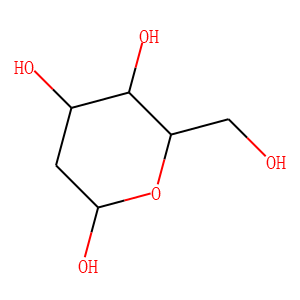| Reference | [1]. Mol Imaging Biol. 2005 Nov-Dec;7(6):388-92. doi: 10.1007/s11307-005-0011-6.<br />
Uptake of a fluorescent deoxyglucose analog (2-NBDG) in tumor cells.<br />
O'Neil RG(1), Wu L, Mullani N.<br />
Author information: (1)Department of Integrative Biology and Pharmacology, University of Texas Health Science Center, 6431 Fannin, Houston, TX 77030, USA. [email protected]<br />
PURPOSE: A new fluorescent analog of D -glucose was recently developed by [Yoshioka K, Takahashi H, Homma T, Sato M, Ki Bong O, Nemoto Y, Matsuoka H (1996) A novel fluorescent derivative of glucose applicable to the assessment of glucose uptake activity of Escherichia coli. Biochim Biophys Acta 1289:5-9] and shown to be transported into normal cells. The purpose of this preliminary study was to assess the use of this fluorescent 2-deoxyglucose analog, 2-[N-(7-nitrobenz-2-oxa-1,3-diaxol-4-yl)amino]-2-deoxyglucose (2-NBDG), as a sensitive probe for monitoring glucose uptake into malignant tumor cells. PROCEDURES: MCF-7 breast cancer epithelial cells were grown and plated on coverslips for analysis of 2-NBDG uptake via fluorescence imaging microscopy. RESULTS: Steady-state fluorescence analysis of 2-NBDG uptake displayed rapid uptake for the first one to five minutes, then slowed, reaching an apparent maximum uptake near 20-30 minutes. Addition of 5 mM D -glucose to the media markedly reduced 2-NBDG uptake. Uptake of 2-NBDG in nonmalignant epithelial cells (M-1 epithelial cells) was slow, averaging less than 20% of that observed for tumorigenic cells, the MCF-7 breast cancer cells and the HepG2 liver cancer cell line. CONCLUSIONS: The preliminary data clearly demonstrate a rapid uptake of 2-NBDG into tumor cells that can be monitored by fluorescence imaging analysis. The uptake displays saturation and competition with D -glucose, all properties expected for 2-NBDG uptake and retention in cancer cells. Additional studies, including comparisons among other malignant cell lines and control cells, will be needed to fully characterize the kinetic properties of 2-NBDG uptake and the potential use of this 2-DG analog as a probe for glucose uptake in malignant cells.<br />
DOI: 10.1007/s11307-005-0011-6 PMID: 16284704<br />
<br />
[2]. Cancer Biother Radiopharm. 2008 Jun;23(3):376-81. doi: 10.1089/cbr.2007.0443.<br />
Review: Deoxyglucose compounds labeled with isotopes different from 18-fuoride: is there a future in clinical practice?<br />
Xiong QF(1), Chen Y.<br />
Author information: (1)Department of Nuclear Medicine, Affiliated Hospital, Luzhou Medical College, Luzhou, Sichuan, China.<br />
There are several radionuclide-labeled derivatives of deoxyglucose (DG) that have been developed including 2-fluro-deoxyglucose, ethylenedicysteine-deoxyglucose, diethylenetriaminepentaacetate-deoxyglucose, N-(2'-hydroxybenzyl)-2-amino-2-deoxy-D-glucose, and methyl D-glucoside that were synthesized and successfully labeled in high labeling fields. The former 4 were used for tumor imaging and methyl-D-glucoside for the diagnosis and the monitoring of the functional status of renal tubules. These derivatives are suitable for imaging examinations when labeled with either fluorine-18 (18F), technetium-99m (99mTc), carbon-11 (11C), or gallium-68 (68Ga). These compounds are suitable both for imaging and for therapy if labeled with rhenium-188 (188Re). In the area of molecular imaging of nuclear medicine, derivatives of radionuclide-labeled deoxyglucose will become an important tool for the diagnosis and carcinoma treatment in the clinic.<br />
DOI: 10.1089/cbr.2007.0443 PMID: 18593371<br />
<br />
[3]. Biochem Pharmacol. 2014 Nov 1;92(1):102-11. doi: 10.1016/j.bcp.2014.07.021. Epub 2014 Jul 30.<br />
Energy restriction mimetic agents to target cancer cells: comparison between 2-deoxyglucose and thiazolidinediones.<br />
Kuntz S(1), Mazerbourg S(1), Boisbrun M(2), Cerella C(3), Diederich M(4), Grillier-Vuissoz I(1), Flament S(5).<br />
Author information: (1)Université de Lorraine, CRAN, UMR 7039, Vandœuvre-lès-Nancy, F-54506, France; CNRS, CRAN, UMR 7039, Vandœuvre-lès-Nancy, F-54506, France. (2)Université de Lorraine, SRSMC, UMR 7565, Vandœuvre-lès-Nancy, F-54506, France; CNRS, SRSMC, UMR 7565, Vandœuvre-lès-Nancy, F-54506, France. (3)Laboratoire de Biologie Moléculaire et Cellulaire du Cancer. Hôpital Kirchberg, L-2540, Luxembourg. (4)Laboratoire de Biologie Moléculaire et Cellulaire du Cancer. Hôpital Kirchberg, L-2540, Luxembourg; Department of Pharmacy, College of Pharmacy, Seoul National University, Seoul 151-742, Korea. (5)Université de Lorraine, CRAN, UMR 7039, Vandœuvre-lès-Nancy, F-54506, France; CNRS, CRAN, UMR 7039, Vandœuvre-lès-Nancy, F-54506, France. Electronic address: [email protected].<br />
The use of energy restriction mimetic agents (ERMAs) to selectively target cancer cells addicted to glycolysis could be a promising therapeutic approach. Thiazolidinediones (TZDs) are synthetic agonists of the nuclear receptor peroxisome proliferator-activated receptor (PPAR)γ that were developed to treat type II diabetes. These compounds also display anticancer effects which appear mainly to be independent of their PPARγ agonist activity but the molecular mechanisms involved in the anticancer action are not yet well understood. Results obtained on ciglitazone derivatives, mainly in prostate cancer cell models, suggest that these compounds could act as ERMAs. In the present paper, we introduce how compounds like 2-deoxyglucose target the Warburg effect and then we discuss the possibility that the PPARγ-independent effects of various TZD could result from their action as ERMAs.<br />
DOI: 10.1016/j.bcp.2014.07.021 PMID: 25083915<br />
<br />
[4]. Nucl Med Biol. 1995 Oct;22(7):829-35. doi: 10.1016/0969-8051(95)00034-u.<br />
Iodine-123-labeled glucose analogs: prospects for a single-photon-emitting analog of fluorine-18-labeled deoxyglucose.<br />
Gatley SJ.<br />
Comment on Nucl Med Biol. 1995 Oct;22(7):875-85.<br />
DOI: 10.1016/0969-8051(95)00034-u PMID: 8547880<br />
<br />
[5]. Biochem Pharmacol. 1987 Jun 15;36(12):1853-61. doi: 10.1016/0006-2952(87)90480-1.<br />
Does deoxyglucose uptake in the brain reflect energy metabolism?<br />
Gjedde A.<br />
DOI: 10.1016/0006-2952(87)90480-1 PMID: 3297067
|

